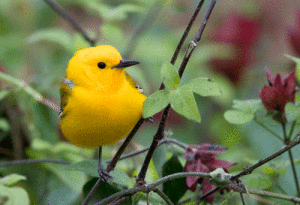
Photo by Mike Williams: In the fall, the Prothonotary Warbler travels from it’s breeding grounds in the U.S. down to its wintering grounds in South America.
Migration is one of the great wonders of the bird world. Despite all of the studies being done and all of the knowledge we have already gained, there is still much that we don’t know about this phenomenon.
Perhaps the greatest mystery is how young birds who hatched over the spring and summer are able to find their wintering grounds all on their own. Imagine a child traveling hundreds of miles to a precise location he’s never visited before, all without directions. Its incredible that these animals know exactly where they’re supposed to go and which routes to take to get there.
The young birds of many species make this journey alone. Ruby-throated Hummingbirds, many small songbirds, and Common Loons are a few examples. Their parents, along with the other birds of their species, travel in the same direction, often towards the same place, but they do so alone and not in a flock. The young birds don’t have anyone to show them where to go, but they still somehow make the journey.
The method behind this navigation is still unknown to us, though we have been studying it for years. A 1964 experiment used Common Starlings, which migrated southwest through the Netherlands to winter in France and Britain. A.C. Perdeck caught thousands of birds in the Netherlands and transported them south-southeast of the capture site for release in Switzerland. The juvenile birds continued flying southwest (their original direction of flight) and flew for a similar distance as they had first intended. This indicated that the birds had an inherent instinct to fly in a certain direction for a certain distance. The starlings are only one example, however, and different species have reacted in different ways to similar experiments.
One of the most well proven methods of migration navigation is the use of stars. Night-time migrators, perhaps looking at constellations, bright stars, or some other indicators are able to use the sky as a compass. This method isn’t flawless, though. The stars can often be covered by clouds and storms, and now humans further muddy the sky with our bright lights, satellites, and cell towers. The birds, who’s instincts tell them to fly towards the light, are drawn towards skyscrapers and lit windows where they crash and fall. This is why we recommend turning off all excess lights at night during fall and spring migration.
Here on the Gulf coast of Texas, we happen to live in a very important bird flyway. Birds, heading from Canada and the Eastern US fly through our neck of the woods as they funnel down towards Mexico. For example, a Prothonotary Warbler who has spent the summer in Minnesota will likely fly almost directly South to Louisiana. When it hits the Gulf Coast, it will turn West and follow the shoreline through Texas, Mexico, and into its winter habitat in South America.
If you want to help migrating birds, turn off your excess lights at night. Keep your cats indoors and away from the weary travelers. Because so many birds are coming through our area during this season, its up to us to make this habitat hospitable to them.
